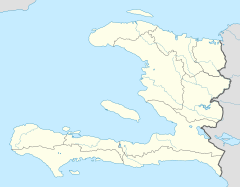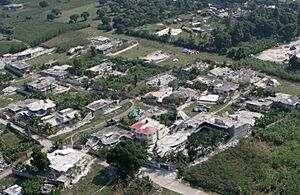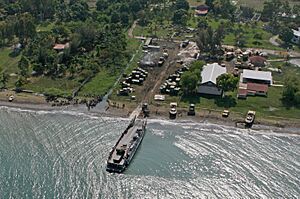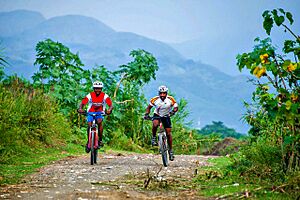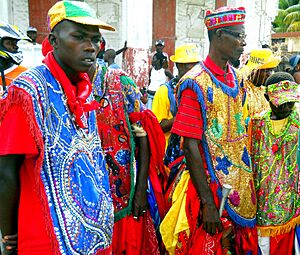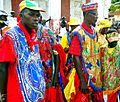Léogâne facts for kids
Quick facts for kids
Léogâne
Leyogàn (Haitian Creole)
Yaguana (Taino) |
|
|---|---|
|
Commune
|
|
| Ville de Léogâne | |
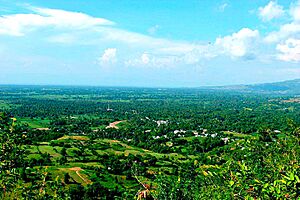 |
|
| Nickname(s):
La cité d'Anacaona (The city of Anacaona)
|
|
| Motto(s):
Je suis Léogânais et je suis fier de l'être (I am Léogânais and I am proud of it)
|
|
| Country | Haiti |
| Department | Ouest |
| Arrondissement | Léogâne |
| Communal sections | 1st. Dessources 2nd. Petite-Rivière 3rd. Grande-Rivière 4th. Fond de Boudin 5th. Palmiste à Vin 6th. Orangers 7th. Aux-Parques 8th. Beauséjour 9th. Citronniers 10th. Fond d'Oie 11th. Gros Morne 12th. Cormiers 13th. Petit-Harpon |
| Demonym | Léogânais(e) |
| Government | |
| • Type | Municipal Government |
| Population | |
| • Total | 90,000 |
| Time zone | UTC-5 (Eastern) |
| • Summer (DST) | UTC-4 (Eastern) |
| Zip Code |
HT 6210
|
| Area code(s) | +509 |
| Website | http://leyogan.com |
| Internet Top Level Domains (TLD) .ht .gouv.ht .edu.ht | |
Léogâne (pronounced Lay-oh-GAHN) is a lively coastal town in Haiti. It's also known as Leyogàn in Haitian Creole. This important port town is about 30 kilometers (19 miles) west of Haiti's capital, Port-au-Prince. Léogâne is famous for its rich culture, including art, music, literature, food, and architecture. It also has cool historical places like Fort Campan.
In 2010, a big earthquake hit right at Léogâne. Most buildings, about 80-90%, were badly damaged. This was a huge challenge for the town.
Contents
History of Léogâne
Early History and Spanish Rule
When Europeans arrived in 1492, Léogâne was called Yaguana. It was the capital of Jaragua, one of the five main areas on the island of Hispaniola. This area was the last part of the island to stay free from Spanish control. The Taíno queen, Anacaona, was born here. She was captured and killed by the Spanish in 1503. In 1592, an English fleet led by Christopher Newport attacked and burned the town.
French Control and Renaming
Later, French adventurers settled the western part of the island. In 1691, the French governor, Jean-Baptiste du Casse, renamed the area Léogâne. This new name still kept some of the old Taino name, Yaguana. In 1697, the French officially gained control of one-third of the island from Spain. They then built a city here.
Revolutions and Key Figures
A big earthquake destroyed the town in 1770. In the early 1790s, a local leader named Romaine-la-Prophétesse led rebels. They took control of Léogâne, destroyed many plantations, and freed enslaved people. During the Haitian Revolution, in 1803, Jean-Jacques Dessalines ordered the town to be burned. This was to force out the last French colonists. Léogâne is also the birthplace of Marie-Claire Heureuse Félicité. She became an Empress of Haiti and was married to Jean-Jacques Dessalines.
Charlemagne Péralte, a leader against the U.S. occupation that started in 1915, was a military officer in Léogâne. He refused to give up to the U.S. troops. He then went back to his hometown and led a group called the Cacos against the occupation.
The 2010 Earthquake in Léogâne
Léogâne was right at the center of the big 7.0 magnitude earthquake on January 12, 2010. A team from the United Nations found that Léogâne was "the worst affected area." About 80 to 90% of buildings were damaged. Almost every concrete building was destroyed. The damage was even worse than in the capital city.
Estimates suggested that 20,000 to 30,000 people died in Léogâne from the earthquake. Many people gathered in temporary camps. Aid took longer to reach Léogâne than the capital.
The city hall was destroyed, so it moved to a telecommunications building. The Sainte Rose de Lima School, which was very important to the city, was also destroyed. Buildings on the main street, the Saint Croix Hospital, and the court building were all badly damaged.
International Aid and Recovery Efforts
Rescue teams from the UK and Iceland were among the first to arrive on January 17, 2010. The Canadian destroyer HMCS Athabaskan arrived on January 19. Its crew helped deliver aid and support relief efforts. A Japanese field hospital, Sri Lankan peacekeepers, and an Argentine field hospital treated survivors.
Many groups helped with medical care. World Wide Village and the University of Notre Dame set up clinics and a new hospital. Other groups like Heart to Heart International and Médecins Sans Frontières also provided medical help.
Since Léogâne has no airport, aid was brought in by helicopter or small planes. A highway, Route 9, was used as a landing strip by UN Peacekeepers. Canadian soldiers helped with security for food distribution.
In February, the Korean government sent 250 peacekeepers. Most were engineers, some were medical troops, and marines provided security. They started building a hospital. The UN Food and Agriculture Organization started a "cash-for-work" program. This helped people earn money by clearing irrigation canals.
Geography and Climate
Location of Léogâne
Léogâne is bordered by the Gulf of Gonâve to the north. To the east is the town of Gressier. To the south are the mountains of the Massif de la Selle. To the west is the town of Grand-Goâve.
Weather in Léogâne
Léogâne has different types of climates depending on the area. The lowland areas are usually warm all year. Temperatures range from 15°C to 25°C in winter. In summer, they are from 25°C to 30°C. The dry mountains have moderate temperatures. The humid mountains are mild and wet all year. The amount of rain each year is between 800 and 1277 millimeters.
Water Resources
Léogâne has six rivers: Rouyonne, Momance, Cormier, Ravine Seche, Haut-Saut, and Courbyon. It also has nineteen streams, two ponds, and a lagoon. The Momance River is the most important. It is widely used to water crops. This river could also be used to create electricity.
Economy of Léogâne
Farming and Fishing
The economy in Léogâne mostly relies on farming. The sugarcane industry is the biggest part of the economy. After sugarcane, the banana industry is important. Grains like maize, sorghum, and rice are also grown. Other crops include sweet potatoes, cassava, beans, and yams. Many people also fish and farm along the coast. Raising chickens and bees has also grown quickly in recent years.
The Jean Léopold Dominique sugar mill in Darbonne makes extra molasses. This is used by smaller alcohol factories in the area. The sugar mill can produce 375,000 metric tons of sugar. It can also create 22 megawatts of electricity.
Coffee Production
Coffee is a very important crop for Haiti's economy. It is a main source of income for farmers in Léogâne's humid mountain areas. About 200,000 families in Haiti grow coffee. At least 20% of their yearly income comes from coffee. This money helps them pay for education, health, and house building. Tombe Gateau Léogâne has Haiti's largest coffee mill. It serves many regions of the country.
Other Industries
Making building materials is also important to the local economy. New construction companies are growing fast. This means that land once used for crops is now being used for buildings. Transportation and private schools also play a role in the economy.
Léogâne is close to Port-au-Prince. This is good for the economy because it means many potential customers. The area also has many young adults ready to work. Léogâne has about 100,000 active farmers.
Tourism in Léogâne
Léogâne has many fun places to visit. These include old historical sites like Fort Campan and Latounèl Gwoso. There is also one of the oldest windmills in the western hemisphere in Baussan.
Léogâne is home to thousands of local plants and animals. You can explore the beautiful nature by walking. Haiti means "Land of high mountains" in the native language. Ten of Léogâne's thirteen sections are in the mountains. These mountains cover over 25,000 acres.
You can also visit natural caves like grotto Belloc, Anacaona, and Fond d'Oie. Léogâne also has 25 kilometers (15.5 miles) of sandy beaches.
Hiking is popular in Léogâne. In 2013, the Léogâne Cycling Club (LCC) hosted a big mountain bike event. This made Léogâne a great place for adventure tourism.
Thousands of people visit Léogâne each year for religious trips. They come to see the many patron Saints in the area. Léogâne has more religious pilgrimage sites than any other place in Haiti.
Léogâne also hosts several cultural events every year. These events attract many visitors. Two famous ones are Rara and Fête Champêtre.
Culture and Traditions
Rara Music and Festival
Léogâne is known as the home of Rara. This is a lively rural festival that started in colonial times. The Rara season begins with the Haitian Carnival and lasts through Lent. It ends during Easter week. Rara is a season, a festival, a type of music, a religious event, a dance, and sometimes a way to protest. Léogâne is famous for its Rara, but it is celebrated all over Haiti in different ways.
Local Rara groups form musical bands that parade for miles. They attract fans and sing old and new songs. Rara bands often stop at important places. These include crossroads, homes of community leaders, and religious spots like cemeteries. There, they honor their ancestors. Musicians play drums, sing, and use bamboo horns and metal trumpets. A typical Rara band has drums, bamboo instruments called vaccine, metal horns called konet, and percussion players. There is also a chorus of singers.
Rara has become important for the local economy. It brings positive attention and helps businesses. It creates income for cultural, tourism, and hospitality industries. This has led to "rara-driven festival tourism." It gives the city a new way to earn money.
Religion in Léogâne
The main church in the city was the Roman Catholic Sainte Rose de Lima Church. It was destroyed in the earthquake.
Education in Léogâne
Since 2005, Léogâne has had an Episcopalian nursing school. It is called Faculté des Sciences Infirmières de l'Université Épiscopale d'Haïti à Léogâne.
A new Catholic school, "Notre Dame des Anges," opened in 2014. It is run by the Jesuits. The Vatican helped fund this school after the 2010 earthquake.
Sports in Léogâne
Léogâne is home to five major sports teams:
- Léogâne Cycling Club (LCC)
- Cavaly Association Sportive Club (CASPORT)
- League Basketball Léogânaise (LBL)
- Valencia Football Club (VFC)
- Anacaona Football Club (AFC)
The Léogâne Cycling Club (LCC) started in 2002. In 2013, they hosted the first International mountain bike competition in Haiti.
The Cavaly Association Sportive Club (CASPORT) is a professional soccer club. It was founded in 1975. They have played in international competitions. Many of their former players have become professional players around the world.
The Valencia Football Club (VFC) is another professional soccer club. It was founded in 1972. They play in Haiti's top national league. Valencia FC won its first national championship in 2012. Many of their former players have also played professionally.
Organizations Helping Léogâne
Johanniter International built a rehabilitation center in Léogâne. They gave it to the Seventh Day Adventist Hospital. They also built six community clinics. They trained over 30,000 villagers in disaster preparation.
Deep Springs International and the Children's Nutrition Program are based in Léogâne.
The University of Notre Dame works with the Sainte Croix Hospital. They help research and treat a mosquito-borne disease called lymphatic filariasis.
GOALS (Global Outreach and Love of Soccer) is an organization in Léogâne. They use soccer to help young people improve health, the environment, and local leadership.
Éditions Ruptures is a publishing company in Léogâne. It started in 2009 to help young Haitian writers publish their work. In 2016, they opened the Josaphat Robert Large Cultural Center. This center offers cultural and educational services.
Notable People from Léogâne
- Anacaona: A Taíno queen born in Yaguana (Léogâne) in 1474. Her name means "golden flower."
- Coupé Cloué: Born Jean Gesner Henry, he was a Haitian footballer, singer, and bandleader. He was born in Tombe Gateau, Léogâne.
- Edwidge Danticat: A Haitian-American author born in Port-au-Prince. Her family is from Mathieu, Léogâne.
- Simone Duvalier: The wife of Haitian President François "Papa Doc" Duvalier. She was born in Orangers, Léogâne.
- Marie-Claire Heureuse Félicité: Empress of Haiti and wife of Jean-Jacques Dessalines. She was born in Léogâne.
- Pierre Garçon: A Haitian-American football wide receiver in the NFL. His family is from Petite-Rivière, Léogâne.
- Joseph Balthazar Inginac: A Haitian general who served as a personal secretary for Haitian presidents.
- Ricardo Pierre-Louis: A Haitian professional soccer player.
- Pascal Millien: A Haitian professional footballer.
Images for kids
See also
 In Spanish: Léogâne para niños
In Spanish: Léogâne para niños


